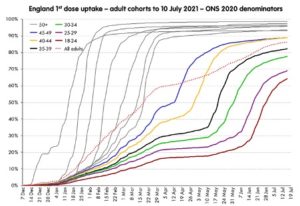A child receives a coronavirus vaccination in Utrecht, Netherlands. (Photo by Patrick van Katwijk/BSR Agency/Getty Images)
There is an irony, which is that on so-called Freedom Day, it was announced that one freedom would not be expanded. Nadhim Zahawi, the vaccine minister, declared yesterday that only extremely vulnerable children between the ages of 12 and 15 would be offered the vaccine: that is, children who have severe disabilities or who are immunocompromised.
The Joint Committee on Vaccination and Immunisation (JCVI) explained that this is the result of a risk-benefit analysis. The JCVI’s Prof Adam Finn in a briefing with the Science Media Centre pointed out that “happily the virus very rarely affects children seriously”, and that the very small risks of adverse effects from the vaccine outweigh the risk to a child of getting, and then becoming ill with, Covid. The UK medicines regulator has declared the Pfizer vaccine safe and effective in children, but the JCVI has a more stringent approach.
Similar calculations were made back in March. At the time, a small number of cases of a rare clotting disease were detected in people who had had the Oxford/AstraZeneca vaccine. As a result, the JCVI recommended that it not be used in the under-40s unless no other options were available.
That decision was based on a straightforward risk-benefit analysis. The risk of a blood clot caused by the vaccine is vanishingly small – about one in 50,000, with the risk of severe health impacts lower still. But young people are also at very low risk of getting severely ill if they develop Covid, and the number of people with Covid at the time was very low – only about 6,000 new cases a day, compared to about 60,000 at the January peak. That meant that the chance of a young person getting infected, and then getting very ill, was even smaller than the risk of a blood clot, as the Winton Centre for Risk and Evidence Communication showed.
“Freedom Day” has happened now. It’s far from clear what effect it will actually have. The Government’s Scientific Pandemic Influenza Group on Modelling (SPI-M-O)’s latest modelling paper, published last week, says that by the end of August, we could end up with fewer than 100 hospitalisations a day, or more than 10,000.
Small changes to our assumptions drive huge changes to the outcomes: will 90% of people stop wearing masks? 70% 50%? Will we all pile into nightclubs and theatres, or only a few of us? We don’t know: these things, or a million others. As the Bristol maths professor Oliver Johnson puts it, “the range of uncertainty around any reasonable forecast probably includes both ‘it’s basically fine’ and ‘we have a very serious problem’.”










Join the discussion
Join like minded readers that support our journalism by becoming a paid subscriber
To join the discussion in the comments, become a paid subscriber.
Join like minded readers that support our journalism, read unlimited articles and enjoy other subscriber-only benefits.
Subscribe